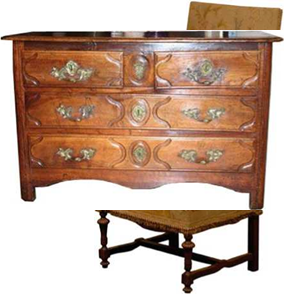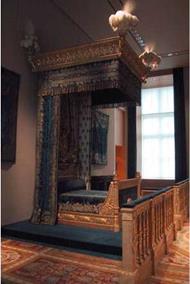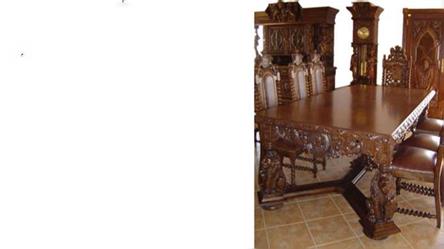The most characteristic pieces of furniture of the Baroque are those of Louis XIV, the absolutist ruler, who gave the majesty of the authority, which he represented, an appropriate exterior form. Therefore, the products manufactured in Manufacture Royale des Meubles de la Couronne founded in 1667 had an adequate aesthetic form. Their characteristic feature is, among others, using flat decorations in case furniture, called marquetry, while in skeletal furniture (such as chairs, armchairs, tables) wood carving decorations. The legs of the furniture mentioned were originally in the form of vertical, four-side beam elements tapered towards the bottom, stabilised at the bottom by connectors made of curved boards. In such cases, the wood was primed and gilded to emphasise the rank and wealth of the user. However, wood carvers were not the most valued craftsmen—the most respected were artists who worked with ebony wood, marqueters and bronzers (Setkowicz 1969; Gostwicka 1981, 1986, 1987).
The most important piece of furniture for sitting was a heavy, padded armchair with a high backrest (Fig. 1.28). Aside from the seat, it was distinguished by an obliquely set backrest, which usually reached above the head of a seated person, as well as an s-shaped bent armrest. The seat tapestry was made of velvet, embroidered fabrics, gobelin, extruded and gilded leather.
During the reign of Louis XIV, new types of furniture appeared, including the chest of drawers, desk, dining table, console tables, table clocks, cabinet clocks, base tables for vases. The chest of drawers replaced the chest and often
 |
complemented tall cupboards in function (Fig. 1.29). Desks were an innovative variation to the escritoire and cabinet from the period of the late Renaissance.
In the bedrooms, the bed was placed in an alcove separated by a balustrade or columns from the rest of the room (Fig. 1.30). The bed was covered over the top with a canopy decorated on the corners with feathers or finials. Also differently than in the Renaissance, the wooden frame of the bed was covered with fabrics completely.
English Baroque furniture was made of walnut wood and gilded, rich wood carving ornaments. Embroidered fabrics, drapery and velvets were also used with rich trimming near the fittings of beds, lining armchairs and sofas. Tables are characterised by a strong resemblance to Dutch tables with screw turned legs.
Fig. 1.30 Louis XIV’s royal bed
 The high backrests of chairs were usually carved and decorated with ornamentation in the form of sashes or acanthus leaves. Case furniture came in the forms of simple bodies. At this time, English furniture used profiling very sparingly and almost completely avoided any cornices. Characteristics of ornamentation of English furniture are marquetery decoration, the use of black and red lacquers according to Chinese designs, and the use of s-shaped bent supports in place of existing banister and volute supports (Setkowicz 1969). The most important piece of box furniture of this period in English furniture was the chest of drawers, which was represented by a chest fitted with drawers. However, there were no large clothes cupboards in England, because clothes during this time were still stored in drawers.
The high backrests of chairs were usually carved and decorated with ornamentation in the form of sashes or acanthus leaves. Case furniture came in the forms of simple bodies. At this time, English furniture used profiling very sparingly and almost completely avoided any cornices. Characteristics of ornamentation of English furniture are marquetery decoration, the use of black and red lacquers according to Chinese designs, and the use of s-shaped bent supports in place of existing banister and volute supports (Setkowicz 1969). The most important piece of box furniture of this period in English furniture was the chest of drawers, which was represented by a chest fitted with drawers. However, there were no large clothes cupboards in England, because clothes during this time were still stored in drawers.
In the seventeenth century in the Netherlands, mostly oak and walnut wood was used, although laminated boards from exotic types of wood were also used: ebony, rosewood and others. Sometimes, the surfaces of furniture were also lined with ivory tiles placed in starry designs or with colourful veneers from exotic trees. An essential type of a Dutch wardrobe during this period was the dual four-door wardrobe. Chairs had the form known already from the late Renaissance, but the legs, like in tables, had the form of screw lines. Dutch Baroque furniture was mainly ordered and made in China. Hence, this also had a significant impact on their further shape, form and purpose. In particular, the impact of Chinese bent frames and bases gave impetus to the transition from the serious and raw forms of Baroque furniture to more casual and mobile Rococo forms.
At the turn of the seventeenth and eighteenth centuries, German wardrobes developed a kind of final shape and constituted a distinctive and recognisable piece of furniture of that period. In German literature, they were called Hamburg
 Fig. 1.31 Replica of Gdansk furniture from the seventieth – eighteenth century—dresser and table (manufacturer of Gdansk furniture Gorlikowski Company, www. gorlikowski. eu/)
Fig. 1.31 Replica of Gdansk furniture from the seventieth – eighteenth century—dresser and table (manufacturer of Gdansk furniture Gorlikowski Company, www. gorlikowski. eu/)
wardrobes, while in Poland—Gdansk wardrobes, as in both of these cities their most representative exponents were produced and collected (Fig. 1.31).
Gdansk wardrobes from the second half of the seventeenth century had a two-storey body embedded on a massive base, while the columns, supporting the expansive entablature took over pilasters that were covered in ornaments. All the surfaces of the wardrobe were devoid of ornamental and sculptural decorations. The horizontal division was indicated by profiled cornices: over the base, between the levels and the crowning cornice. The architectural composition of the wardrobes was emphasised by three columns on each level. Gdansk wardrobes were made of oak or coniferous wood, veneered with walnut wood, enriching the colour with inserts of ebony or dark-brown oak wood. At the end of the seventeenth century, there was a breakthrough in the form and function of wardrobes. The division into two levels disappeared, and the interior above the massive base was not divided. Such a design made it possible to hang clothes on fixed hangers. A refined piece of furniture in the high hallways of middle-class tenement buildings was a hallway wardrobe (Fig. 1.32). It was a massive structure having rich wood carving decorations and exposed cornices. The one-level, large-sized body was placed on a low base with drawers (Setkowicz 1969; Gostwicka 1981, 1986, 1987; Swaczyna 1992).



